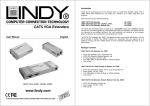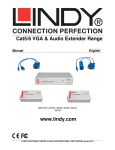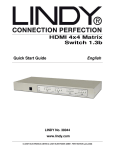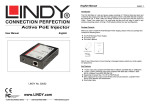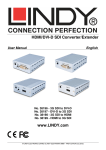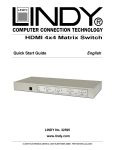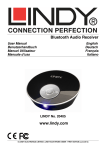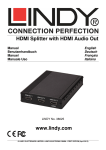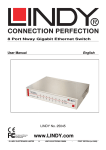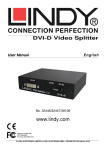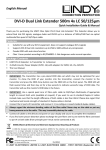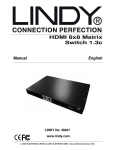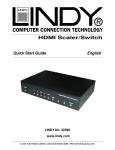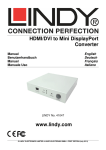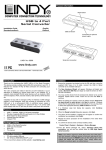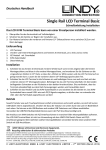Download Lindy 38054 video splitter
Transcript
HDMI 1.4 4x2 Switching Splitter Manual English LINDY No. 38054 www.lindy.com © LINDY ELECTRONICS LIMITED & LINDY-ELEKTRONIK GMBH - FIRST EDITION (July 2011) Manual English Introduction Thank you for purchasing the LINDY HDMI 1.4 4x2 Switching Splitter with remote control. This high performance switch offers you the maximum convenience in HDMI signal distribution when you have multiple HDMI sources and displays to connect together. Each of the four HDMI sources can be directed to both HDMI displays, so your displays can show the same source picture at the same time. When the HDMI signal is progressed through the switch it is retimed and level compensated, so that the output is a regenerated HDMI signal that can travel another 10 metres. The switch also supports 3D video with protocols that will allow 3D displays and sources to communicate through a HDMI link. Each of the output ports support audio return channel (ARC) and HDMI Ethernet channel (HEC) meeting the HDMI 1.4 specification. The audio can also be outputted through the co-axial SPDIF port to an AV amp to receive true audio from the sink. HEC adds a connection to the HDMI link which is capable of carrying a 100Mbps full duplex Ethernet connection. Package Contents • • • • HDMI 1.4 4x2 Switching Splitter 5V DC 2.6A multi country power supply Remote control (inc CR2025 battery) This manual Features • • • • • • • • • • HDMI 1.4 compliant o Audio return channel (ARC) o 3D o CEC o HDMI Ethernet channel (HEC) high speed, bi-directional networking up to 100Mbps Supports HDTV resolutions: 480i, 480p, 576i, 576p, 720p, 1080i and 1080p Audio support o HDMI 1.4 compatible audio interface o Dolby TrueHD o DTS-HD Master audio o Full audio input & output support When used with computers, supports DVI-D resolutions up to UXGA (1600 x 1200) Supports both DVI-D source and display devices when using DVI-D/HDMI adapter cables Each input/output can support up to 10 metres HDCP repeater support 24/30/36 bit deep colour support Dimensions: 240 x 104 x 44mm (WxDxH) Total weight: 1.27Kg 1 Manual English Connection & Operation Make sure all devices are switched off before making any connections! Once all the connections have been made, switch on the devices in this order: displays, HDMI Switch, source devices. 1. IR Remote Control sensor: Using the included remote control, you can select any of the connected inputs 2. LED Indicators: The HDMI switch will automatically detect the incoming audio/video signal and illuminate the LED’s accordingly 3. Input Selection: A blue LED will illuminate when you press the input button to select any of the connected sources 4. EDID Selection: Select either the STD (onboard EDID setting) or TV (display attached to output port 1) for the EDID setting. To lock the EDID setting, press and hold the EDID button for 3 seconds and the “lock” LED will illuminate red 5. Power button: Press to switch on the device and then press it again to put the device in standby 1. RS232 Port: This port can be used to upgrade the firmware or allow control of the switch via a serial cable 2. HDMI / Audio / Ethernet out: a. HDMI: Connect your HDMI displays to the two HDMI out ports b. Audio: Using SPDIF coaxial cable, connect these ports to your external amp c. Ethernet: You can connect a PC or laptop to these ports to utilise the Ethernet signal coming from your displays via the HEC 3. HDMI Input: Connect your HDMI source equipment to these input ports 4. Power: Attach the included 5V DC PSU to this port Note: To utilise all the functions of this switch, you must use HDMI cables that support ARC and HEC connections. If using a device connected to the output port with ARC and have selected an input with audio. The SPDIF port will give priority to the ARC signal. If you want to use the audio from the input signal, you must disable ARC in the connected displays menu. 2 Manual English Remote Control 1. Power Button: Press to switch on the device and then press it again to put the device in standby 2. Input Selection: Press any of the buttons 1 – 4 to select the desired source RS-232 Protocol - Pin definition Baud Rate: 9600bps Data bit: 8 bits Parity: None Stop bit: 1 bit Flow control: None 4x2 HDMI Switch PIN Definition 1 NC 2 Tx 3 Rx 4 NC 5 GND 6 NC 7 NC 8 NC 9 NC Remote Control Console PIN Definition 1 NC 2 Rx 3 Tx 4 NC 5 GND 6 NC 7 NC 8 NC 9 NC ► ◄ Command Command POWER 00 POWER 01 PORT 11 PORT 12 PORT 13 PORT 14 PORT 21 PORT 22 PORT 23 PORT 24 Action Power Off (standby) Power On Output Select Input 1 Output Select Input 2 Output Select Input 3 Output Select Input 4 Output Select Input 1 Output Select Input 2 Output Select Input 3 Output Select Input 4 Notes on using DVI-D equipped devices: To connect devices equipped with DVID connections, you can use either modular DVI/HDMI adapters or DVI/HDMI adapter cables. Be aware that DVI-D is a ‘video only’ interface; audio signals are not supported when using DVI-D source devices. Also, please note that DVI-D equipped displays must support HDCP signal decoding to display HDCP protected HDMI signals. HDCP compatible displays will normally feature the HD Ready logo. 3 Manual English 4 CE/FCC & Recycling Information CE Certification This equipment complies with the requirements relating to Electromagnetic Compatibility Standards EN55022/EN55024 and the further Standards cited therein. FCC Certification This equipment has been tested and found to comply with the limits for a Class B digital device, pursuant to part 15 of the FCC F Rules. These limits are designed to provide reasonable protection against harmful interference in a residential installation. You ou are cautioned that changes or modification not expressly approved by the party responsible for compliance could void your authority to operate the equipment. This device complies with part 15 of the FCC Rules. Operation is subject to the following two conditions: onditions: 1. This device may not cause harmful interference, and 2. This device must accept any interference received, including interference that may cause undesired operation. WEEE (Waste of Electrical and Electronic Equipment), Recycling of Electronic Products United Kingdom In 2006 the European Union introduced regulations (WEEE) for the collection and recycling of all waste electrical and electronic electro equipment. It is no longer allowable to simply throw away electrical and electronic electronic equipment. Instead, these products must enter the recycling process. Each individual EU member state has implemented the WEEE regulations into national law in slightly different ways. Please follow your national law when you want to dispose of any electrical or electronic products. More details can be obtained from your national WEEE recycling agency. Germany Die Europäische Union hat mit der WEEE Direktive umfassende Regelungen für die Verschrottung und das Recycling von Elektro- und Elektronikprodukten rodukten geschaffen. Diese wurden von der Bundesregierung im ElektroElektro- und Elektronikgerätegesetz – ElektroG in deutsches Recht umgesetzt. Dieses Gesetz verbietet vom 24.März 2006 an das Entsorgen von entsprechenden, auch alten, Elektro- und Elektronikgeräten en über die Hausmülltonne! Diese Geräte müssen den lokalen Sammelsystemen bzw. örtlichen Sammelstellen zugeführt werden! Dort werden sie kostenlos entgegen genommen. Die Kosten für den weiteren Recyclingprozess übernimmt die Gesamtheit der Gerätehersteller. Geräteherstelle France En 2006, l'union Européenne a introduit la nouvelle réglementation (DEEE) pour le recyclage de tout équipement électrique et e électronique. Chaque Etat membre de l’ Union Européenne a mis en application la nouvelle réglementation DEEE de manières légèrement différentes. Veuillez suivre le décret d’application correspondant à l’élimination des déchets électriques ou électroniques de d votre pays. Italy Nel 2006 l’unione europea ha introdotto regolamentazioni (WEEE) per la raccolta e il riciclo riciclo di apparecchi elettrici ed elettronici. Non è più consentito semplicemente gettare queste apparecchiature, devono essere riciclate. Ogni stato membro dell’ EU ha tramutato le direttive WEEE in leggi statali in varie misure. Fare riferimento alle leggi del proprio Stato quando si dispone di un apparecchio elettrico o elettronico. Per ulteriori dettagli fare riferimento alla direttiva WEEE sul riciclaggio del proprio Stato. LINDY No. 38054 1st Edition July 2011 www.lindy.com 5








